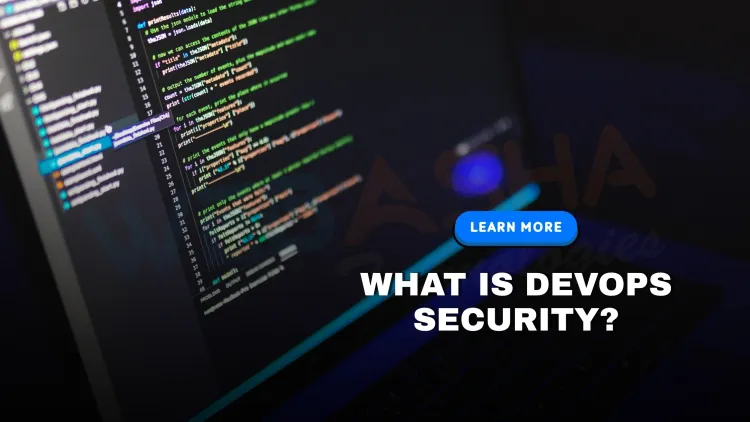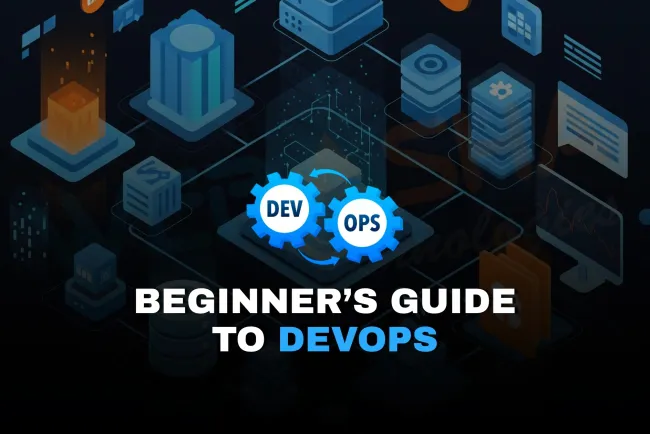What Is DevOps Security? Best Practices, Challenges & Tools for Secure DevOps in 2025
Learn everything about DevOps security, from its core concepts to the biggest challenges and best practices. Discover how to integrate security into CI/CD pipelines, tools to use, and why DevSecOps is essential in 2025.

Table of Contents
- What is DevOps Security?
- Why DevOps Needs Security Built-In
- Key Challenges in DevOps Security
- Best Practices for DevOps Security
- Tools Commonly Used in DevOps Security
- Real-World Example: Secure DevOps Pipeline
- Conclusion
- Frequently Asked Questions (FAQs)
In today’s fast-paced digital world, DevOps helps companies deliver software faster—but with great speed comes great responsibility. Security is often overlooked in the rush to deploy quickly. That’s where DevOps security comes in.
This blog explores what DevOps security means, why it matters, the challenges teams face, and real-world best practices to build safer, more secure systems—without slowing down development.
What is DevOps Security?
DevOps security, also known as DevSecOps, is about integrating security practices into every stage of the software development and deployment process. Instead of treating security as a final step, it’s “shifted left” to be part of coding, building, testing, and releasing software.
Think of it like building a house: you wouldn’t wait until after it’s built to add locks and alarms. Security has to be part of the foundation.
Why DevOps Needs Security Built-In
DevOps encourages speed—developers push code frequently, and automated pipelines deploy changes in minutes. But without security, this speed can lead to vulnerabilities slipping through the cracks.
Security in DevOps helps:
-
Detect issues early
-
Reduce costly breaches
-
Ensure compliance (e.g., PCI-DSS, HIPAA)
-
Build customer trust
Example:
Netflix, a DevOps pioneer, includes automated security scans as part of its CI/CD pipelines to catch vulnerabilities before code goes live.
Key Challenges in DevOps Security
Despite its benefits, implementing DevOps security isn’t easy. Here are some common roadblocks:
1. Speed vs. Security Conflict
Developers want fast deployments. Security teams want strict reviews. Finding the right balance is tough.
2. Tool Overload
DevOps stacks often include dozens of tools—integrating security into each of them can be complex.
3. Lack of Security Training
Developers may not be trained in secure coding or threat modeling, leading to gaps in code.
4. Poor Visibility
With frequent code changes and dynamic cloud infrastructure, it’s hard to track what’s secure and what’s not.
✅ Best Practices for DevOps Security
To succeed, security must be automated, developer-friendly, and part of the DevOps workflow. Here’s how to do it:
1. Shift Security Left
Start security early—at the code and design stage. Use tools like static analysis (SAST) during development.
2. Automate Security Testing
Integrate security tools like Snyk, SonarQube, and Checkmarx into your CI/CD pipelines. Automate code scans, vulnerability checks, and container analysis.
3. Use Infrastructure as Code (IaC) Securely
When using Terraform or AWS CloudFormation, scan templates for misconfigurations using tools like tfsec or Checkov.
4. Implement Least Privilege Access
Use role-based access control (RBAC) and identity providers to limit who can access what.
5. Monitor Everything
Use centralized logging and security monitoring tools (like ELK Stack, Splunk, or AWS GuardDuty) to detect anomalies.
6. Container Security
Scan Docker images for known vulnerabilities before they’re deployed. Use trusted base images and signed containers.
7. Policy-as-Code
Define security policies (like network rules or allowed packages) in code using tools like Open Policy Agent (OPA).
Tools Commonly Used in DevOps Security
| Tool Name | Purpose |
|---|---|
| Snyk | Open-source dependency scanning |
| Checkmarx | Static code analysis (SAST) |
| Trivy | Container image scanning |
| HashiCorp Vault | Secrets management |
| Aqua Security | Kubernetes runtime protection |
| Terraform + tfsec | IaC and policy validation |
Real-World Example: Secure DevOps Pipeline
Here’s what a secure DevOps pipeline might look like:
-
Developer pushes code to Git.
-
Static code analysis runs instantly (e.g., SonarQube).
-
Unit tests and SAST scans happen in parallel.
-
Container builds are scanned (e.g., Trivy).
-
IaC templates are validated for security issues.
-
If all checks pass, deployment proceeds to staging or production.
Conclusion
DevOps and security don’t have to be at odds. By building security into your pipelines from the start, teams can move fast and stay safe.
DevSecOps is more than a buzzword—it’s the future of modern software development. Whether you're a startup or a large enterprise, investing in DevOps security today will protect you from breaches, downtime, and non-compliance tomorrow.
FAQ
What is DevOps security?
DevOps security is the integration of cybersecurity practices into DevOps processes to ensure secure and reliable software delivery.
How does DevSecOps differ from DevOps?
DevSecOps adds security into every phase of the DevOps lifecycle rather than treating it as a separate stage.
Why is security important in DevOps?
Security ensures that rapid development and deployment don’t introduce vulnerabilities that attackers can exploit.
What are the main goals of DevSecOps?
The primary goals include early detection of vulnerabilities, automated security testing, and secure infrastructure.
How is CI/CD secured in DevOps?
CI/CD is secured using practices like code signing, automated vulnerability scanning, and access control in pipelines.
What are the common security risks in DevOps?
Common risks include misconfigured infrastructure, exposed secrets, insecure code, and lack of access controls.
What is shift-left security in DevOps?
Shift-left security means implementing security measures earlier in the software development process, such as during coding and testing.
What tools are used for DevOps security?
Tools include SAST, DAST, dependency scanners, secrets managers, and CI/CD security integrations.
How can secrets be managed securely in DevOps?
Use tools like HashiCorp Vault, AWS Secrets Manager, or Azure Key Vault to securely store and manage credentials.
What is policy-as-code in DevOps security?
Policy-as-code allows defining and enforcing security policies through code, ensuring consistency across environments.
How does Infrastructure as Code (IaC) impact security?
IaC can introduce risks if misconfigured. Scanning IaC templates for vulnerabilities is essential for security.
What are secure coding practices in DevOps?
These include input validation, secure authentication, avoiding hardcoded secrets, and following coding standards.
How is container security handled in DevOps?
It involves scanning container images, using minimal base images, and implementing runtime protection.
What are the best practices for securing Kubernetes in DevOps?
Use RBAC, network policies, audit logs, and pod security standards to secure Kubernetes environments.
What is continuous security testing?
It refers to automatically testing code and configurations for vulnerabilities throughout the DevOps lifecycle.
How can teams foster a security-first DevOps culture?
Promote collaboration, provide security training, and integrate security into daily workflows.
How do you secure CI/CD pipelines?
Use access controls, sign artifacts, scan builds, and ensure pipeline isolation and integrity.
What is runtime security monitoring?
It involves observing applications and infrastructure in production to detect anomalies and breaches.
How does threat modeling fit into DevOps security?
Threat modeling helps identify potential security threats early in the development process.
Can automation help with DevOps security?
Yes, automation speeds up detection, patching, compliance checks, and response to incidents.
How can version control improve DevOps security?
Version control ensures changes are auditable and trackable, which helps detect unauthorized changes.
What’s the role of logging and monitoring in DevSecOps?
They provide real-time visibility into systems and help identify security issues quickly.
How does compliance work in DevOps environments?
Automated checks and reports can ensure your system stays compliant with regulations like GDPR or HIPAA.
Is penetration testing still needed in DevOps?
Yes, it's essential to test from an attacker’s perspective, even if automated scanning is in place.
What’s the biggest challenge in DevSecOps adoption?
Cultural resistance, lack of security knowledge among developers, and tool integration can be major hurdles.
How do you train developers in DevOps security?
Through regular workshops, secure coding bootcamps, and hands-on experience with security tools.
What is least privilege access in DevOps?
It means giving users and services only the permissions they need to perform their tasks.
How often should security reviews be done in DevOps?
Ideally, after every major code change and regularly as part of sprint cycles.
Are cloud-native applications more secure in DevOps?
They can be, but only if cloud configurations, containers, and orchestration tools are properly secured.
What metrics are useful in DevSecOps?
Useful metrics include vulnerability resolution time, scan coverage, false positive rate, and mean time to detect/respond (MTTD/MTTR).














![Top 10 Ethical Hackers in the World [2025]](https://www.webasha.com/blog/uploads/images/202408/image_100x75_66c2f983c207b.webp)








